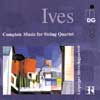Ives Complete String Quartet Works
Warmly affectionate performances but Ives really needs a more compelling touch
View record and artist detailsRecord and Artist Details
Composer or Director: Charles Ives
Genre:
Chamber
Label: Gold
Magazine Review Date: 3/2003
Media Format: CD or Download
Media Runtime: 66
Mastering:
Stereo
DDD
Catalogue Number: MDG307 1143-2

Tracks:
| Composition | Artist Credit |
|---|---|
| String Quartet No. 1, 'From the Salvation Army' |
Charles Ives, Composer
Charles Ives, Composer Leipzig Qt |
| String Quartet No. 2 |
Charles Ives, Composer
Charles Ives, Composer Leipzig Qt |
| Halloween |
Charles Ives, Composer
Charles Ives, Composer Leipzig Qt Steffen Schleiermacher, Piano |
| Largo Risoluto, Movement: Prelude and Statement (of the law of diminishing r |
Charles Ives, Composer
Charles Ives, Composer Leipzig Qt Steffen Schleiermacher, Piano |
| Largo Risoluto, Movement: A Shadow made a Silouette |
Charles Ives, Composer
Charles Ives, Composer Leipzig Qt Steffen Schleiermacher, Piano |
| (A) Set of Three Short Pieces, Movement: Scherzo: Holding Your Own |
Charles Ives, Composer
Charles Ives, Composer Leipzig Qt |
| (A) Set of Three Short Pieces, Movement: Adagio cantabile: The Innate |
Charles Ives, Composer
Charles Ives, Composer Leipzig Qt Steffen Schleiermacher, Piano |
| Adagio sostenuto |
Charles Ives, Composer
Charles Ives, Composer Leipzig Qt Steffen Schleiermacher, Piano Yeon-Hee Kwak, Cor anglais |
Author: Andrew Farach-Colton
These performances emphasise the European roots of Ives’s quartet music. The Leipzig play the second movement of the early Quartet No 1 (1896), for example, with a gentle lilt that brings Dvorák to mind. Their warmly gracious interpretation is perfectly valid, of course, though the friskier version by the Emerson Quartet (with the syncopations very sharply articulated) speaks in a more readily recognisable American accent. The Adagio cantabile third movement is quite lovely – the delicacy with which the Leipzig phrase the central Allegretto episode (beginning at 2'00") is especially beautiful – but in the finale, the unrelieved smoothness of the playing irons out the music’s quirks. Still, those who want a sense of how Ives’s music looks back to its predecessors might find the Leipzig’s performance to be enlightening.
The Second Quartet (1907-13) is a mature work, however, and here the Leipzig’s fluid approach seems entirely out of place. Ives’s evocative programme note – ‘four men who converse, discuss, argue (in re Politick), fight, shake hands, shut up, then walk up the mountainside to view the firmament!’ – may only give a skeletal view of the work’s dramatic form, but it at least indicates something of the music’s character. The Leipzig play with warm affection, but their expressivity is far too generalised. ‘Arguments,’ the aptly titled central movement, is too polite, and the slow, outer movements are sluggish and shapeless. Turn again to the Emerson to find a compellingly bracing performance in which each line is given its own personality.
So, although the Leipzig include a selection of shorter pieces, the Emerson’s DG disc (coupling the two Ives quartets with the Scherzo and Barber’s Quartet, Op 11) is to be greatly preferred.
The Second Quartet (1907-13) is a mature work, however, and here the Leipzig’s fluid approach seems entirely out of place. Ives’s evocative programme note – ‘four men who converse, discuss, argue (in re Politick), fight, shake hands, shut up, then walk up the mountainside to view the firmament!’ – may only give a skeletal view of the work’s dramatic form, but it at least indicates something of the music’s character. The Leipzig play with warm affection, but their expressivity is far too generalised. ‘Arguments,’ the aptly titled central movement, is too polite, and the slow, outer movements are sluggish and shapeless. Turn again to the Emerson to find a compellingly bracing performance in which each line is given its own personality.
So, although the Leipzig include a selection of shorter pieces, the Emerson’s DG disc (coupling the two Ives quartets with the Scherzo and Barber’s Quartet, Op 11) is to be greatly preferred.
Discover the world's largest classical music catalogue with Presto Music.

Gramophone Digital Club
- Digital Edition
- Digital Archive
- Reviews Database
- Full website access
From £8.75 / month
Subscribe
Gramophone Full Club
- Print Edition
- Digital Edition
- Digital Archive
- Reviews Database
- Full website access
From £11.00 / month
Subscribe
If you are a library, university or other organisation that would be interested in an institutional subscription to Gramophone please click here for further information.




